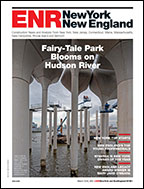Manhattan's Hudson Yards District Takes Off












































Structural engineer Thomas Z. Scarangello is no stranger to the Long Island Railroad's West Side Yard in Manhattan, which is going under cover thanks to the 28-acre Hudson Yards development.
The current chairman and CEO of Thornton Tomasetti (TT) first studied the yard in the late 1990s, when there was talk of a baseball park there. And he was involved again when New York City made its bid for the 2012 Olympic Games, with the west part of the site designated for the Olympic stadium. When London won the bid, Scarangello stayed involved as part of a failed effort to build a Jets football stadium at the site.
Soon after that, in 2005, New York City rezoned the area from manufacturing to commercial and residential, creating the Special Hudson Yards District. The goal of the rezoning was to create a pedestrian-friendly, transit-oriented, mixed-use district. Toward that end, the state would build a 1.5-mile extension to the No. 7 subway line, which would terminate in the heart of the district's new park at 34th Street. In 2009, the city added the 13-acre western half of the West Side Yard to the mix.
The rezoned area has capacity for 26 million sq ft of office development, 20,000 units of housing—including nearly 5,000 designated affordable—2 million sq ft of retail and 3 million sq ft of hotel space. Other real estate firms, including Brookfield Properties and Tishman Speyer, have joined Related Cos., which is building the 28-acre Hudson Yards, in redeveloping the district.
The Metropolitan Transit Authority, which owns the railyard, hired Thornton Tomasetti to help with the technical content of its request for proposals for the air-rights Hudson Yards project, which ultimately was awarded to Related Cos. TT's work paid off: It is the engineer for the first-phase's 13-acre platform over the east yard, two high-rises, and the retail and cultural buildings. "All those studies allowed us to take something much more complex and really understand all the stakeholders' challenges and needs," says Scarangello.
















